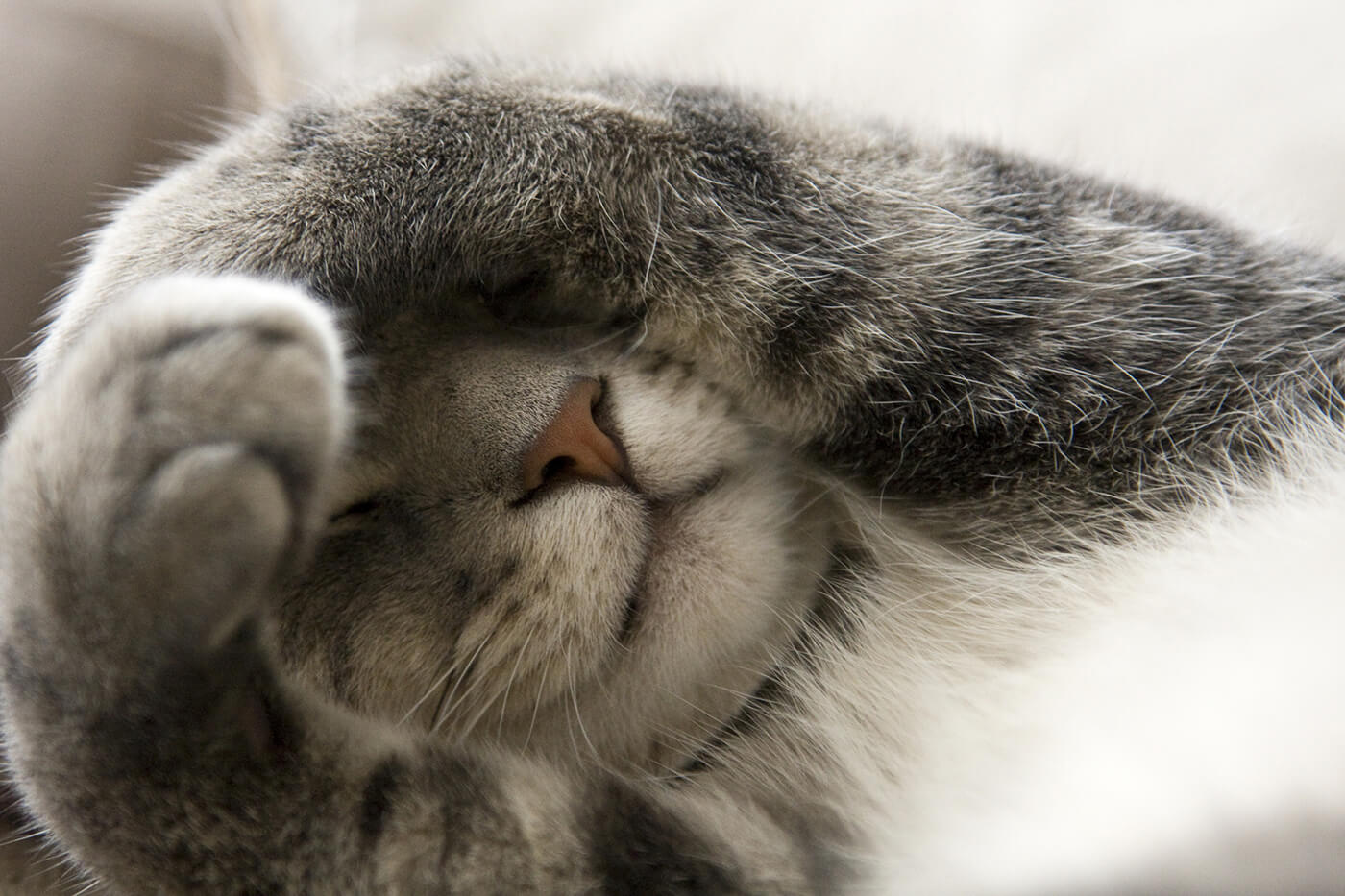BG3P3
BGFWH
BFKSK
BD8PX
BDSTV
BDXY7
Feline leukaemia virus (FELV)
Disease overview
Feline leukaemia virus (FeLV) is an important viral infection of cats which causes a wide variety of secondary problems including immunosuppression, anaemia, and cancer. Most persistently infected cats will die as a result of their infection. The virus is mostly spread through social contact e.g. mutual grooming, sharing of food bowls, litter trays. The virus can also be transmitted through fighting.
Feline leukaemia virus (FeLV)
How is it diagnosed?
- Diagnosis is confirmed by a blood test for feline leukaemia virus.
Clinical signs
- The clinical signs associated with progressive feline leukaemia virus infections are variable and are related to the type of secondary problem which the cat develops e.g. immunosuppression, anaemia, and cancers such as leukaemia
- Signs may include weight loss, poor coat condition, decreased appetite, lethargy, pale gums, persistent diarrhoea, fever.
Risk factors
- Younger cats are at higher risk although cats of all ages can be infected
- Cats with outdoor access
- Cats in multi-cat households living with infected cats or cats of unknown feline leukaemia virus status.
Treatment
- Treatment involves management of any secondary diseases which develop e.g. anaemia, secondary bacterial or viral infections, cancer
- There is no cure for feline leukaemia virus.
Prevention
- Vaccination is very effective at preventing disease caused by feline leukaemia virus.
- Keeping cats strictly indoors can reduce the risk of infection
- Testing all new kittens or adult cats for feline leukaemia virus before bringing them into the household.
Feline allergic dermatitis
Disease overview
An allergy occurs when the immune system reacts or over reacts to substances that are usually harmless. Allergic dermatitis involves allergies which result in skin problems and can be caused by many different allergens including environmental substances, food ingredients and parasites e.g. fleas. It can sometimes be very difficult to confirm the exact cause of the allergy.
Feline Allergic Dermatitis
Possible causes include:
- Fleas – cats can become allergic to flea saliva from flea bites
- Food ingredients
- Environmental allergens that the cat breathes in or absorbs through the skin, such as dust mites, pollen or moulds.
How is it diagnosed?
- Confirmation of the exact cause may not always be possible and other potential causes need to be ruled out
- Your vet will examine any skin lesions to assess for any secondary problems or potential causes e.g. bacterial infections or parasites.
- Samples may be taken from the skin/hair for microscopic examination to look for evidence of infection (e.g. bacterial, fungal) or parasites
- An elimination diet may be recommended by your vet if a food allergy is suspected
- Intradermal skin testing may be used where allergens are injected into the skin to assess for a hypersensitivity reaction.
Clinical signs may include
- Itchiness (pruritus) leading to scratching and/or over grooming
- Inflamed, irritated areas of skin
- Scabs or crusts on the surface of the skin
- Thickened areas of skin with pigment changes
- Thinning hair or hair loss
- Inflammation or infection of the ears.
Risk factors
- There may be a genetic susceptibility to certain allergens in some cats
- Cats not on regular (year round) and effective flea control are at risk of flea allergies.
Treatment options
- Treatment will be dependent on your vet’s assessment of the skin lesions and likely causes
- Eradicating fleas on the cat and in the home is very important as flea allergies are common
- Feeding an elimination diet may be recommended if a food allergy is suspected
- Medications to treat fungal and/or bacterial infections may be required
- Medications to reduce itchiness and scratching may be required.
Prevention
- Prevention may not be possible as not all allergens can be avoided
- Optimal flea control is very important as fleas may be the cause of the allergy or make other skin problems worse
- Reducing levels of dust mites and moulds in the home if environmental allergens are suspected
- If a food allergy is confirmed then feeding a diet without the food ingredient should prevent the signs (with veterinary advice).
Feline diabetes mellitus
Disease overview
Diabetes mellitus is a complex but common disease in cats in which the cat either doesn’t produce or doesn’t properly use insulin. Insulin is a hormone produced in the cat’s pancreas and is responsible for regulating the flow of sugar from the bloodstream into the cells of the body for energy. When insufficient insulin is produced, the cat starts breaking down tissue such as fat to use as an alternative energy source.
Feline Diabetes Mellitus
Possible causes
- Obesity
- High levels of sugar in the bloodstream
- Chronic pancreatitis or other hormonal diseases
- Drugs such as corticosteroids
- Exact cause is usually unknown.
How is it diagnosed?
- Diagnosis is based on a combination of clinical signs, physical examination, urinalysis and blood tests
- Persistent and abnormally high levels of sugar in the blood and urine or high levels of fructosamine in the blood
- Tests may need to be repeated over a few days to confirm diagnosis
- May need additional laboratory tests to check for other diseases.
Clinical signs
- Increase in urination
- Compensatory increase in thirst
- Weight loss
- Increased appetite
- Weakness and unsteadiness
- Poor coat
- Lethargy
- Urinary tract infections.
Risk factors
- Obesity
- More common in male cats
- Older age
- History of chronic pancreatitis or other hormonal diseases
- History of certain drugs
- Genetic susceptibility in Burmese breed.
Treatment
- Most diabetic cats will need injectable insulin to control blood sugar levels
- Regular monitoring of glucose levels by a veterinarian to determine insulin dosage during initial stages
- Diet with moderate to high levels of fibre, high protein and reduced carbohydrates
- Gradually reducing weight in obese cats
- Low-stress environment
- No cure but can be controlled with insulin, exercise and proper nutrition.
Prevention
- Maintain cat’s healthy weight
- If your cat is obese, implement a weight loss program
- Consistently feed your cat a healthy, balanced diet
- Encourage exercise – even an indoor cat can be active.
Sources
Feline upper respiratory tract infections
Disease overview
Viral or bacterial infections of the upper respiratory tract are common in cats. There are several viruses and bacteria which can cause disease of the upper respiratory tract. Vaccines are available for some but not all of them. Transmission is usually by direct or close contact between cats e.g. in sneezed droplets. Therefore cats in crowded environments are at higher risk e.g. boarding facilities and animal shelters.
Feline upper respiratory tract infections
Possible causes include:
Viruses:
- Feline calicivirus
- Feline herpesvirus
Bacteria:
- Chlamydia felis – a common cause of conjunctivitis, especially in young cats
- Others: Bordetella bronchiseptica, Mycoplasma.
Diagnosis
- There may be a history of a possible recent exposure to respiratory diseases e.g. a visit to a boarding facility
- Veterinary physical examination
- Swabs may be taken from the eyes, nose or throat for testing to identify viruses and bacteria which may be causing the signs.
Clinical signs
- Sneezing
- Nasal congestion
- Discharge from the nose
- Coughing
- Ulceration of the lips or the inside of the mouth
- Redness, swelling, squinting of the eyes
- Discharge from the eyes
- Fever
- Reduced appetite
- Lethargy
- Laboured or rapid breathing may indicate pneumonia which is an uncommon but serious potential complication
- Cats infected with feline herpesvirus become life-long carriers of the virus, and after the initial signs resolve, some will suffer from recurrent problems throughout their lives.
Risk factors
- Unvaccinated kittens and cats are at an increased risk
- Cats with suppressed immune systems e.g. feline immunodeficiency virus (FIV) infection
- Cats in boarding facilities, shelters or visiting cat shows
- Multi-cat households
- Stress
- Poor overall health.
Treatment
- Antibiotics may be given to cats with viral infections to treat secondary bacterial infections
- Topical eye ointments may be used if the eyes are affected
- Chlamydia felis infections require long courses of oral antibiotics and all in-contact cats should also be treated
- In severe cases hospitalisation may be required
- Highly palatable food to improve appetite
- Antiviral medications may help with the signs of feline herpesvirus infection.
Prevention
- Vaccines are available for feline calicivirus, feline herpesvirus and Chlamydia felis
- Vaccination cannot prevent infection but it can markedly reduce the severity of the signs
- Vaccination against feline herpesvirus and feline calicivirus is recommended for all cats, regardless of lifestyle
- Isolate infected cats from other cats in the household
- Wash hands to avoid passing infections to an uninfected cat
- Minimise stress
- Avoid taking the cat to overcrowded environments.
Feline ringworm
Disease overview
Ringworm isn’t caused by a worm as its name suggests, but is a highly contagious fungus, also known as dermatophytosis, that infects the skin, hair and nails of cats. It can spread to other pets and is zoonotic, which means it can spread to humans, too.
Feline Ringworm
Possible causes
- The Microsporum canis organism is responsible for most infections in cats, dogs and humans
- Direct contact with a ringworm-infected pet or human
- Indirect contact with skin cells or hair of infected pets or humans (e.g. via a brush, or a surface the skin has rubbed on)
- May occur after flea infestation through bites on the skin
- Ringworm fungus spores are hardy and can remain infectious in the environment for up to two years.
How is it diagnosed?
- Patchy, circular areas of hair loss with central red rings
- Rarely noticed in pets just by looking at the skin
- More visible on human skin
- Some types of ringworm fluoresce under ultraviolet light
- Microscopic examination of affected hairs
- Culture of the fungus from hair and skin scrapings
- Important to distinguish from allergic skin diseases.
Clinical signs
The condition does not usually cause itchiness. Signs are variable and can include:
- Hair loss on skin of the head, ears or legs
- Claws that are rough, pitted and develop a scaly base.
Pet owners may not be aware of infection of pets for many months. Sometimes it is first diagnosed due to spread of infection to in-contact humans.
Risk factors
- Kittens less than 1 year old
- Longhaired cats
- Cats who are immunosuppressed
- Rapid spread in shelters or other crowded environments
- Warm, humid conditions.
Treatment
All in-contact animals must be treated to prevent re-infection
- Oral, antifungal drugs
- Medicated shampoos or creams
- Re-treat over several months
- Skin cultures rechecked periodically by veterinarian
- Decontaminate all bedding, baskets, collars, toys, food and water bowls, and grooming tools by washing with disinfectant prescribed by veterinarian
- Discard items that are impossible to disinfect, such as carpeted cat poles/posts
- Vacuum floors and carpet to rid house of infected hairs and skin cells
- Wash hands after bathing or touching an infected pet.
Prevention
- Routine veterinarian checks for recurrence on pets
- Check any new cat or dog before bringing them into household.
Sources


